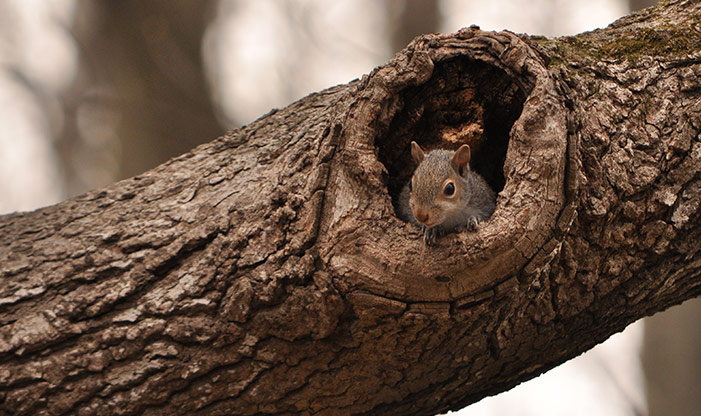Everyone has likely been in the company of squirrels. Wisconsin is home to seven species of these industrious rodents, and at Schlitz Audubon, the eastern gray squirrel and the American red squirrel are the most recognized. Both gray and red squirrels live throughout the property, but each type has its own unique features and strategies to survive a Wisconsin winter.
Characteristics of Two Squirrel Species
Eastern gray squirrels (Scriurus carolinensis) are opportunistic foragers who will eat a variety of foods including nuts, flowers, berries, insects, bird eggs, frogs and more. Their diverse diet leads them to inhabit hardwood deciduous forests with multifarious understory vegetation. They will construct summer homes roughly 30 feet high in the fork of a tree using leaves and interlocking small branches lined with grass, moss, and other soft materials. Building and maintaining a second or even third leaf nest isn’t uncommon. It provides alternative shelters should the main nest be detected by predators, infested by insects, or if the local food cache is plundered.
American red squirrels (Tamiasciurus hudsonicus) succeed in dense coniferous or mixed forests where the tree canopies are interlocked. While the red squirrel forages for a diverse array of foods, the bulk of their diet is made up of pine seeds. Pine trees, such as the abundant scotch pine on the Schlitz Audubon property, do not feature limbs sufficient for building leaf nests, so red squirrels tend to nest in natural cavities or underground.
Different Strategies for Storing Food
As fall approaches, both gray and red squirrels become highly active from dawn until dusk, hoarding food and storing it in order to prepare for the upcoming winter. This behavior is common among rodents during times of surplus in preparation for times of shortage.
Gray squirrels use scatter hoarding, creating a large number of small caches of a single food item spread throughout a territory. Scatter hoarding is not random, but rather involves keen observation and craftiness. If a competitor is watching and waiting to steal food, the squirrel will “fake” bury the nuts in that location, or will remove food from one cache and relocate it. Studies show that the squirrels recover about half of their caches. Because they scatter so many caches throughout a habitat and territories can overlap, they depend more on memory rather than scent to find buried food.
In contrast, red squirrels use larder hoarding as a strategy. Rather than create hundreds of small caches, they store almost all of their food in one large cache, called a midden. Located in a central area of their territory, the majority of their food is placed in trees. The midden is easy to locate, with the base of the tree littered with pine cone scales.
Defending Their Territory
This leads red squirrels to be intense defenders of their territory. Despite being the smaller of the two squirrel species, they can be very aggressive, chasing most competition away. Their most common defense is through vocal communication. A rattle, buzz, or loud chirp can advertise their territory and threaten any nearby competitors from coming too close to their midden. At the Center, an extensive red squirrel midden is located near the observation tower beneath the large pines, and red squirrels are often seen or heard there.
Despite their best efforts, not every seed or nut buried by a squirrel will be found later to be consumed, leading to regeneration of trees in the forest. Next time you enjoy a hike through the forests of Schlitz Audubon, thank a squirrel for the trees and habitat they helped create.


